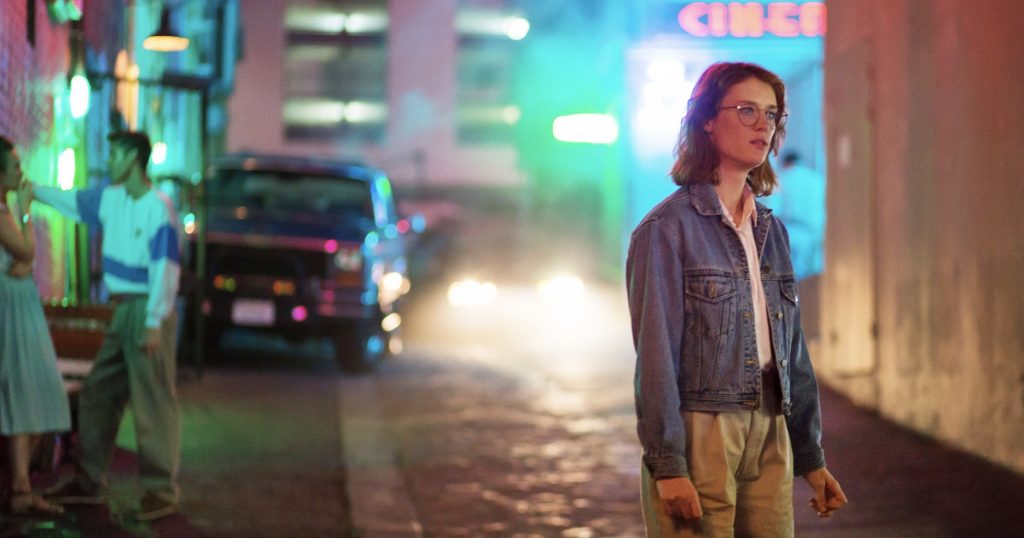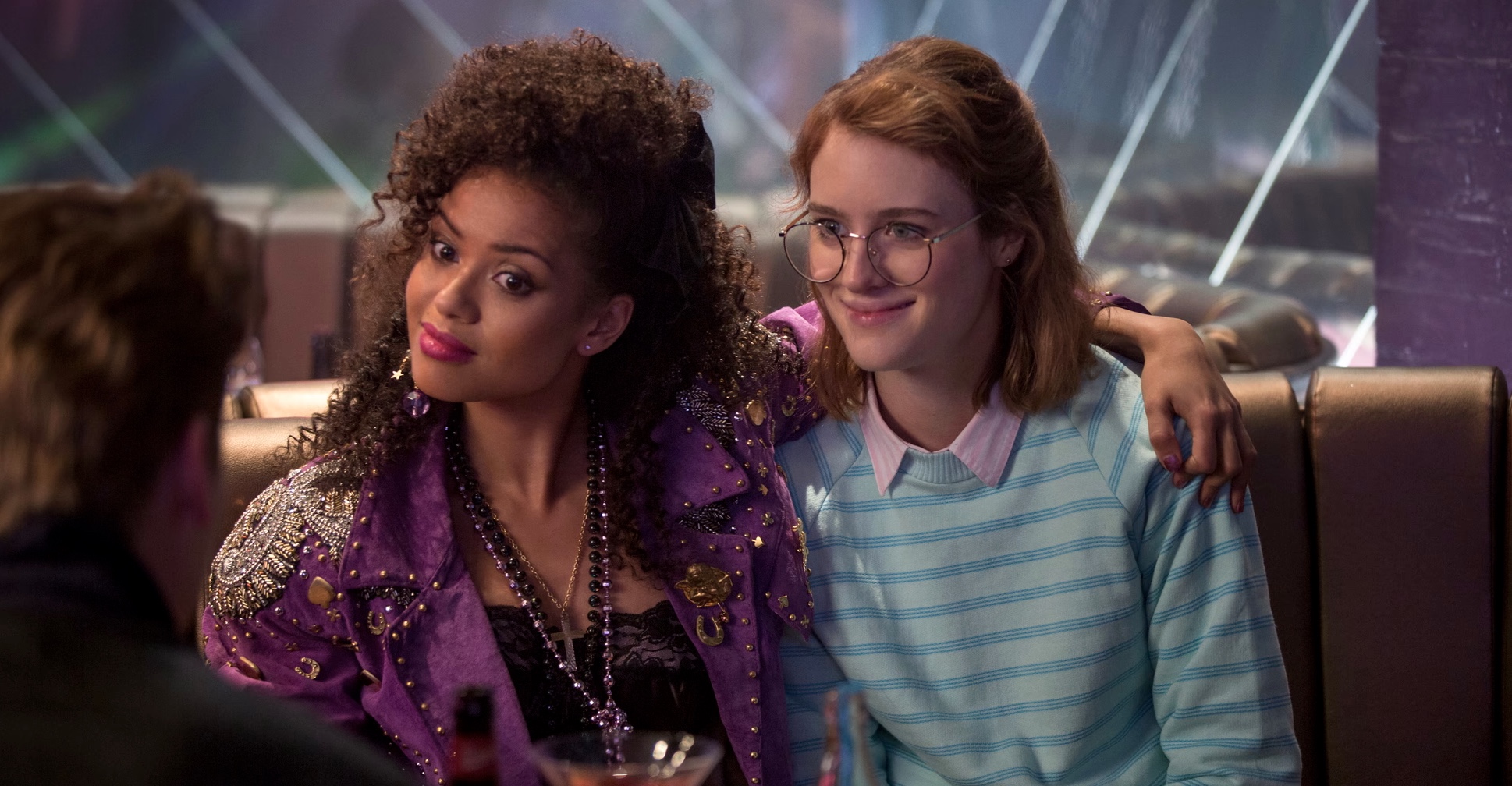Core Data:
- Vision: A digital afterlife, where users can live out eternity on a hard drive
- Type: Popular culture – TV
- As Seen In: Black Mirror episode ‘San Junipero’
- Envisioned: 2016
- Visionary: Charlie Brooker
- Target Date: The near future (probably first half of the 21st century)
Overview:
Black Mirror, Charlie Brooker’s 21st century take on The Twilight Zone, is generally associated with dystopian visions of lives ruined by technology. ‘San Junipero’ is the story that broke the mould, an Emmy-winning episode that introduced romance and even – whisper it – an upbeat ending into the anthology series’ mix.
The 2016 standalone focuses on Kelly (Gugu Mbatha-Raw) and Yorkie (Mackenzie Davis), two young women who fall in love in the ’80s nostalgia fest of the eponymous California town. This being Black Mirror, however, there’s a twist in the tale, as we learn that San Junipero is a simulation, and that – in the real world – Kelly and Yorkie are much older and approaching the end of their lives.
So while it’s an undeniably a love story – boasting a killer ’80s soundtrack – it’s also a lot more, as a trip to this idyllic coastal resort allows Brooker to explore complex themes of loss, virtual reality and life after death.

Key Tenets:
- Experience: Users visit a totally immersive simulation of an idyllic fictional Californian coastal town called San Junipero. Whether they want to dance, walk on the beach or enjoy sexual encounters, the experience is entirely realistic.
- Users’ avatars are generally an idealised version of their 20-something selves.
- Users can choose to visit the town in different time periods. These trips back in time are the past as you’d see it in a movie – the ’80s version of San Junipero, for example, is heavily inspired by John Hughes classics Pretty In Pink and Ferris Bueller’s Day Off.
- Plenty of era-appropriate fashion is available, and users can switch their outfits in an instant.
- Videogames, music and movies are also era-appropriate, and they also have a habit of echoing the storyline: Belinda Carlisle’s ‘Heaven Is A Place On Earth’ and The Smiths’ ‘Girlfriend In A Coma’ feature prominently on the soundtrack, while House Of The Dead and Time Crisis are available in the town’s arcade.
- It’s always sunny in San Junipero, except when a bit of rain can assist in the storytelling. “Charlie [Brooker] wasn’t sure about the logic of rain,” recalls director Owen Harris, “but I couldn’t imagine the alleyway scene outside Tucker’s [the bar where Kelly and Yorkie share one of their first romantic moments] without it. I clung on to it like a dog with a bone.”
- Users looking for a more extreme experience can visit fetishistic out-of-town nightclub the Quagmire.
- If a user is being harassed, they can give the guilty party a “red-light”.
- Users can also adjust their “pain sliders” to control how much sensation they feel.
- The elderly are offered the opportunity to trial San Junipero for five hours a week. When the clock strikes midnight, they do a Cinderella and disappear from the simulation.
- If users enjoy what’s on offer, they can sign up to have their consciousness permanently uploaded to San Junipero after they die.
- Some users (such as Yorkie) can choose when they “pass over”. That said, some US states – such as California – have restrictions to prevent people being euthanised because they’ve become addicted to the San Junipero experience. The “triple lock” requires sign-off from the patient, a consenting family member and a doctor.
- Not everyone wants to sign up to the digital afterlife. Kelly’s late husband felt it would be unfair if he had the chance to live forever when their daughter – who died at 39 – did not.
- Forever can be a long time and it’s possible for the deceased to grow bored of life in San Junipero – there are stories of users who spend all their time getting kinkier and kinkier in the Quagmire, just so they can feel something.
- Hardware: Living users hook themselves up to the San Junipero simulation using a small neural interface – the size of a coin, it attaches to the temple, and connects to the system wirelessly.
- There is also a small handheld controller used to turn the connection on and off.
- The San Junipero simulation is housed in a large server farm-type facility run by TCKR Systems.
- When a client who has signed up to the program dies, their consciousness is converted into digital form and transferred to cylindrical storage devices. These are then added to the TCKR Systems mainframe, to ‘live’ forever in San Junipero.
- Company:It’s not clear whether they have a monopoly on the life-after-death technology, but TCKR Systems manage the San Junipero simulation.
- TCKR Systems also appear in the Black Mirror episodes ‘Black Museum’, ‘Striking Vipers’ and ‘Playtest’. The company is widely believed to be a descendant of Tuckersoft, the software developer in interactive episode ‘Bandersnatch’.
- In a clever piece of additional marketing, the bar/night club that appears across the various eras in San Junipero is called Tucker’s.
- Economics: It’s not explained how San Junipero is paid for – though it’s unlikely TCKR Systems’ motives are purely altruistic. Care homes and other medical facilities have access to the simulation, and elderly residents are offered weekly five-hour tester sessions where they can get a feel for the technology. TCKR are presumably banking on these free samples being enough to persuade the customer to sign up for their afterlife plan, in much the same way as a TV or music streaming service gives new subscribers a free trial. It seems likely that the model involves the deceased’s estate paying a regular maintenance fee to TCKR, though in the case of the quadriplegic Yorkie – who’s been in a coma for 40 years and has been disowned by her family – it’s unclear where that money has come from.
- IP: As long as they’re appropriate to the time period of the simulation, it seems that all videogames, music, TV shows and movies can be viewed within the system.
State of Play (March 2022)
- Hardware: Right now, immersive virtual reality experiences require a headset such as an Oculus Quest 2, which uses stereoscopic screens to create 3D visuals for the user.
- Simulating the sensation of touch requires haptic gloves – though the technology can’t provide the depth of sensory experiences on offer in San Junipero.
- Neural interfaces can be used to deliver simple commands directly from the human brain to computers or games. However, they’re nowhere near the sophistication required to exchange the quantities of data necessary to run the San Junipero simulation.
- But the bigger challenge to overcome is how you’d transfer an entire human consciousness into the digital realm. Michael SA Graziano, a professor of psychology and neuroscience at Princeton University, writes in the Wall Street Journal that, “I am convinced that mind uploading will happen some day. There are no laws of physics that stand in the way. It depends, however, on technology that has not yet been invented, so nobody knows when mind uploading might become unavailable.”
- To make such a procedure possible, Graziano says we’d need to work out how to build an artificial device capable of simulating the 86 billion neurons in the human brain; and thn how to copy a person’s brain so that the consciousness can be transferred to an artificial version. “Nobody knows if those two steps would really recreate a person’s mind or if other, subtler aspects of the biology of the brain must be copied as well, but it’s a good starting place.”
- Experience: Black Mirror has always been more concerned about the psychological and societal impacts of a futuristic technology than its plausibility. “We always have a scientific explanation for things, even if it’s bollocks!” says executive producer Annabel Jones. “We introduced the idea of digital consciousness in ‘White Christmas’ [where Rafe Spall’s character is forced to experience time at 1,000 years per minute], but hadn’t really explored the moral or emotional implications. There was so much untapped potential [in San Junipero].”
- For as long as there have been humans, we’ve been looking for ways to prolong our lives. But, if immortality suddenly became a feasible option (even if it was just digital), would society as a whole able to handle the moral, economic and religious implications of a tangible life after death?
- The rights of the deceased would also have to be considered. Would they be the property of the company operating the servers they live on? Or would they still be regarded as living beings, with their own free will?
- Society would also have to consider how the living and dead communicate with each other.
- Economics: There’s possibly no limit to how much people would be prepared to pay for the chance to speak to a deceased loved one. If a company chose to exploit grief, their profits could be bigger than anything in the history of business – after all, controlling the afterlife would be truly world-changing technology.
Reality check: not impossible but can we deal with the moral implications?
The ability to transfer the human mind into a digital environment is still some way off – if it’s even possible at all – but it may be child’s play compared to getting our heads around bona fide life after death. In this case, technology could be some way ahead of the human mind’s capacity to deal with its implications.
Further reference:
A self-confessed full-time geek, freelance journalist Richard has spent most of his career writing about sci-fi and fantasy – including more than a decade on staff for SFX magazine. He's particularly keen on franchises with "Star" in the title.



































